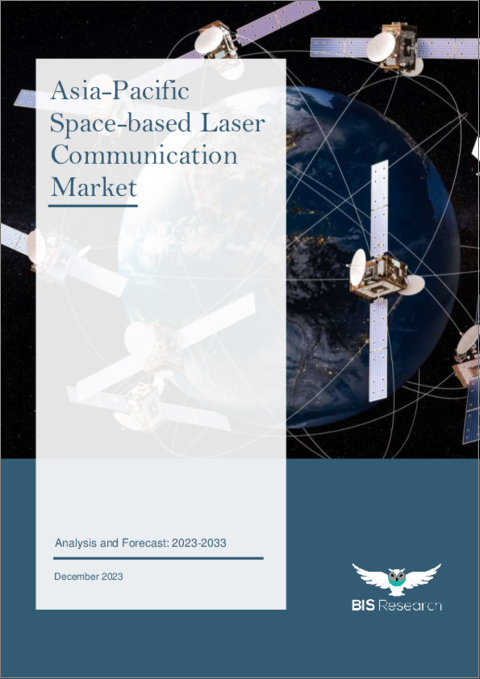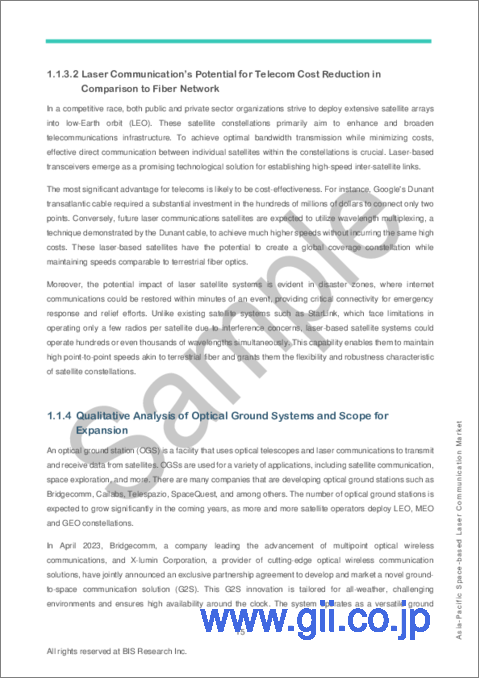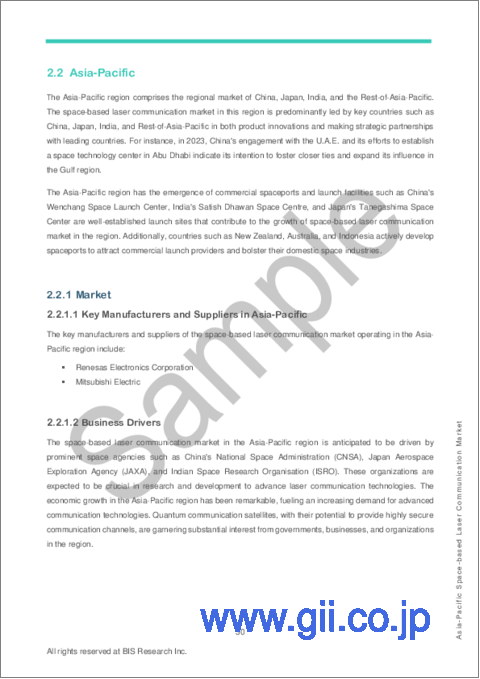|
|
市場調査レポート
商品コード
1395423
アジア太平洋の宇宙ベースレーザー通信市場 - 分析と予測(2023年~2033年)Asia-Pacific Space-based Laser Communication Market - Analysis and Forecast, 2023-2033 |
||||||
カスタマイズ可能
|
|||||||
| アジア太平洋の宇宙ベースレーザー通信市場 - 分析と予測(2023年~2033年) |
|
出版日: 2023年12月14日
発行: BIS Research
ページ情報: 英文 77 Pages
納期: 1~5営業日
|
全表示
- 概要
- 図表
- 目次
アジア太平洋の宇宙ベースレーザー通信の市場規模は、2022年に約1億2,000万米ドルとなりました。
同市場は、2033年には28億8,000万米ドルに達すると予測され、予測期間の2023年~2033年のCAGRは26.38%と見込まれています。衛星間リンク(ISL)を備えた第2世代衛星の導入以来、宇宙ベースのレーザ通信市場は大きく成長しています。人工知能(AI)、電子制御アンテナ(ESA)、部品の小型化、衛星間リンク(ISL)など、地上と宇宙空間の両方で通信性能を向上させる技術が、この成長の主な原動力となっています。
| 主要市場統計 | |
|---|---|
| 予測期間 | 2023年~2033年 |
| 2023年の評価額 | 2億7,000万米ドル |
| 2033年予測 | 28億8,000万米ドル |
| CAGR | 26.38% |
アジア太平洋における宇宙ベースのレーザー通信市場は、近年大きく成長し、進歩しています。衛星ネットワークの能力を向上させ、デジタルデバイドを埋める可能性を持つレーザーベースの衛星通信は、実行可能な選択肢を提示しています。エッジコンピューティング、仮想プライベートネットワーク、先進的な5G/6Gサービス、宇宙とのシームレスなインターネット接続など、多くの目的に利用できます。さらに、レーザーベースの衛星通信が提供できるもう1つの有用なアプリケーションは、空中にある資産と通信する能力です。
さらに、アジア太平洋の衛星コンステレーションが市場を牽引すると予想されています。これらの衛星コンステレーションは、全世界またはほぼ全世界をカバーし、衛星の常時利用を保証し、全地球測位システム、データ中継、通信、地球観測などの用途のための切れ目のない接続とデータ収集を容易にします。衛星コンステレーションは、APAC地域の通信、宇宙探査、気候監視、監視、セキュリティなどの産業に新たな可能性を提供します。
当レポートでは、アジア太平洋の宇宙ベースレーザー通信市場について調査し、市場の概要とともに、エンドユーザー別、ソリューション別、地域別の動向、および市場に参入する企業のプロファイルなどを提供しています。
目次
エグゼクティブサマリー
調査範囲
第1章 市場
- 業界の展望
- ビジネスダイナミクス
第2章 アジア太平洋
- 宇宙ベースレーザー通信市場(地域別)
- アジア太平洋
- 市場
- 用途
- 製品
- アジア太平洋(国別)
第3章 市場-競合ベンチマーキングと企業プロファイル
- 競合ベンチマーキング
- その他の主要参入企業
第4章 調査手法
List of Figures
- Figure 1: Space-Based Laser Communication Market, Units, 2022-2033
- Figure 2: Space-Based Laser Communication Market, $Billion, 2022-2033
- Figure 3: Space-Based Laser Communication Market (by End User), $Billion, 2023 and 2033
- Figure 4: Space-Based Laser Communication Market (by End User), Units, 2023 and 2033
- Figure 5: Space-Based Laser Communication Market (by Solution), Units, 2023 and 2033
- Figure 6: Space-Based Laser Communication Market (by Solution), $Million, 2023 and 2033
- Figure 7: Space-Based Laser Communication Market (by Region), $Billion, 2033
- Figure 8: Space-based Laser Communication Market, 2023-2033
- Figure 9: Supply Chain Analysis for the Space-Based Laser Communication Market
- Figure 10: Space-Based Laser Communication Market, Business Dynamics
- Figure 11: Share of Key Business Strategies and Developments, January 2020-June 2023
- Figure 12: Space-Based Laser Communication Market:Competitive Benchmarking, 2022
- Figure 13: Research Methodology
- Figure 14: Top-Down and Bottom-Up Approach
- Figure 15: Assumptions and Limitations
List of Tables
- Table 1: Start-Ups and Investment Scenario
- Table 2: New Product Launches, Developments, and Others, January 2020-July 2023
- Table 3: Partnerships, Collaborations, Agreements, Contract and Others, January 2020-June 2023
- Table 4: Space-Based Laser Communication Market (by Region), Units and $Million, 2022-2033
- Table 5: Asia-Pacific Space-Based Laser Communication Market (by End User), Units and $Million, 2022-2033
- Table 6: Asia-Pacific Space-Based Laser Communication Market (by Solution), Units and $Million, 2022-2033
- Table 7: China Space-Based Laser Communication Market (by End User), Units and $Million, 2022-2033
- Table 8: China Space-Based Laser Communication Market (by Solution), Units and $Million, 2022-2033
- Table 9: India Space-Based Laser Communication Market (by End User), Units and $Million, 2022-2033
- Table 10: India Space-Based Laser Communication Market (by Solution), Units and $Million, 2022-2033
- Table 11: Japan Space-Based Laser Communication Market (by End User), Units and $Million, 2022-2033
- Table 12: Japan Space-Based Laser Communication Market (by Solution), Units and $Million, 2022-2033
- Table 13: Rest-of-Asia-Pacific Space-Based Laser Communication Market (by End User), Units and $Million, 2022-2033
- Table 14: Rest-of-Asia-Pacific Space-Based Laser Communication Market (by Solution), Units and $Million, 2022-2033
- Table 15: Benchmarking and Weightage Parameters
“The Asia-Pacific space-based laser communication market Expected to Reach $2.88 Billion by 2033.”
Introduction to Asia-Pacific (APAC) Space-Based Laser Communication Market
In 2022, the Asia-Pacific region generated around $0.12 billion in 2022 and is expected to reach $2.88 billion by 2033, registering a CAGR of 26.38% during the forecast period 2023-2033. Since the introduction of second-generation satellites with intersatellite links (ISL), the market for space-based laser communication has grown significantly. Technologies that improve communication performance both on Earth and in space, like artificial intelligence (AI), electronically steered antennas (ESAs), part miniaturization, and intersatellite linkages (ISLs), are the main drivers of this growth.
| KEY MARKET STATISTICS | |
|---|---|
| Forecast Period | 2023 - 2033 |
| 2023 Evaluation | $0.27 Billion |
| 2033 Forecast | $2.88 Billion |
| CAGR | 26.38% |
Market Introduction
The market for space-based laser communication in the Asia-Pacific region has grown and advanced significantly in recent years. With the potential to improve satellite networks' capabilities and bridge the digital divide, laser-based satellite communication presents a viable option. It can be used for a number of purposes, including edge computing, virtual private networks, advanced 5G/6G services, and seamless internet connectivity to and from space. Furthermore, another useful application that laser-based satellite communication can offer is the capacity to communicate with assets that are in the air.
Furthermore, satellite constellations in the Asia-Pacific area are anticipated to drive the market. These constellations provide worldwide or nearly worldwide coverage, guaranteeing constant satellite availability and facilitating unbroken connectivity and data gathering for uses such as global positioning systems, data relay, telecommunications, and Earth observation. Satellite constellations offer new possibilities for industries such as telecommunications, space exploration, climate monitoring, surveillance, and security in the APAC region.
Market Segmentation:
Segmentation 1: by End User
- Government and Military
- Commercial
Segmentation 2: by Solution
- Space-to-Space
- Space-to-Other Application
- Space-to-Ground Station
Segmentation 3: by Region
- Asia-Pacific - China, India, Japan, and Rest-of-Asia-Pacific
How can this report add value to an organization?
Growth/Marketing Strategy: The APAC space-based laser communication market has seen major development by key players operating in the market, such as contract, collaboration, and joint venture. The favored strategy for the companies has been contracts to strengthen their position in the global space-based laser communication market.
Competitive Strategy: Key players in the APAC space-based laser communication market analyzed and profiled in the study involve major space-based laser communication companies providing components. Moreover, a detailed market share analysis of the players operating in the space-based laser communication market has been done to help the reader understand how players stack against each other, presenting a clear market landscape. Additionally, comprehensive competitive strategies such as partnerships, agreements, and collaborations will aid the reader in understanding the untapped revenue pockets in the market.
Methodology: The research methodology design adopted for this specific study includes a mix of data collected from primary and secondary data sources. Both primary resources (key players, market leaders, and in-house experts) and secondary research (a host of paid and unpaid databases), along with analytical tools, are employed to build the predictive and forecast models.
Table of Contents
Executive Summary
Scope of the Study
1. Market
- 1.1. Industry Outlook
- 1.1.1. Space-Based Laser Communication Market: An Overview
- 1.1.2. Current and Emerging Technological Trends
- 1.1.2.1. Development of Smaller and Lighter Laser Communication Systems
- 1.1.2.2. Multicarrier Modulation (MCM) to Enhance Operational Efficiency in Satellite Connectivity
- 1.1.3. Advancements in Laser Communication Technology and the Potential for Global Coverage
- 1.1.3.1. Revolutionizing Communication: Advantages of Laser Communications Over Traditional Methods (Fiber Connection)
- 1.1.3.2. Laser Communication's Potential for Telecom Cost Reduction in Comparison to Fiber Network
- 1.1.4. Qualitative Analysis of Optical Ground Systems and Scope for Expansion
- 1.1.5. Ongoing and Upcoming Projects
- 1.1.5.1. Space-Based Adaptive Communications Node Program (Space-BACN)
- 1.1.5.2. Deep Space Optical Communications (DSOC)
- 1.1.5.3. Development and Demonstration of Inter-Satellite Optical Communication Network System
- 1.1.5.4. BlackJack Program
- 1.1.5.5. Integrated LCRD Low-Earth Orbit User Modem and Amplifier Terminal (ILLUMA-T)
- 1.1.5.6. Network of Optical Stations for Data Transfer to Earth from Space (NODES)
- 1.1.5.7. Artemis 2 Optical Communications System (O2O)
- 1.1.6. Mega Constellation: A Key Driver for the Expansion of the Space-Based Laser Communication Market
- 1.1.6.1. Increasing Deployment of Mega Constellation
- 1.1.7. Scenario Comparison: Space-based Laser Communication Market
- 1.1.8. Start-Ups and Investment Scenario
- 1.1.9. Supply Chain Analysis
- 1.2. Business Dynamics
- 1.2.1. Business Drivers
- 1.2.1.1. Deployment of Quantum Key Distribution for Secure Data Exchange
- 1.2.1.2. Rising Demand for High-Speed Data Transmission
- 1.2.1.3. Low Data Latency Using GEO Relay or LEO Constellation
- 1.2.2. Business Challenges
- 1.2.2.1. Distortions in Laser Signals During Space-to-Ground Communication
- 1.2.2.2. Use of Higher Optical Power in Comparison to Terrestrial Application
- 1.2.2.3. Need for Accurate Beam Pointing
- 1.2.3. Business Strategies
- 1.2.3.1. New Product Launches, Developments, and Others
- 1.2.4. Corporate Strategies
- 1.2.4.1. Partnerships, Collaborations, Agreements, Contracts and Others
- 1.2.5. Business Opportunities
- 1.2.5.1. Direct Data Downstream from LEO Earth Observation Satellites-to-Ground
- 1.2.5.2. Enhancement and Development of Optical Ground Station Design for Coherent Communication
- 1.2.1. Business Drivers
2. Asia-Pacific
- 2.1. Space-Based Laser Communication Market (by Region)
- 2.2. Asia-Pacific
- 2.2.1. Market
- 2.2.1.1. Key Manufacturers and Suppliers in Asia-Pacific
- 2.2.1.2. Business Drivers
- 2.2.1.3. Business Challenges
- 2.2.2. Application
- 2.2.2.1. Asia-Pacific Space-Based Laser Communication Market (by End User), Value and Volume Data
- 2.2.3. Product
- 2.2.3.1. Asia-Pacific Space-Based Laser Communication Market (by Solution), Value and Volume Data
- 2.2.4. Asia-Pacific (by Country)
- 2.2.4.1. China
- 2.2.4.1.1. Market
- 2.2.4.1.1.1. Key Manufacturers and Suppliers in China
- 2.2.4.1.2. Application
- 2.2.4.1.2.1. China Space-Based Laser Communication Market (by End User), Value and Volume Data
- 2.2.4.1.3. Product
- 2.2.4.1.3.1. China Space-Based Laser Communication Market (by Solution), Value and Volume Data
- 2.2.4.1.1. Market
- 2.2.4.2. India
- 2.2.4.2.1. Market
- 2.2.4.2.1.1. Key Manufacturers and Suppliers in India
- 2.2.4.2.2. Application
- 2.2.4.2.2.1. India Space-Based Laser Communication Market (by End User), Value and Volume Data
- 2.2.4.2.3. Product
- 2.2.4.2.3.1. India Space-Based Laser Communication Market (by Solution), Value and Volume Data
- 2.2.4.2.1. Market
- 2.2.4.3. Japan
- 2.2.4.3.1. Market
- 2.2.4.3.1.1. Key Manufacturers and Suppliers in Japan
- 2.2.4.3.2. Application
- 2.2.4.3.2.1. Japan Space-Based Laser Communication Market (by End User), Value and Volume Data
- 2.2.4.3.3. Product
- 2.2.4.3.3.1. Japan Space-Based Laser Communication Market (by Solution), Value and Volume Data
- 2.2.4.3.1. Market
- 2.2.4.4. Rest-of-Asia-Pacific
- 2.2.4.4.1. Market
- 2.2.4.4.1.1. Key Manufacturers and Suppliers in Rest-of-Asia-Pacific
- 2.2.4.4.2. Application
- 2.2.4.4.2.1. Rest-of-Asia-Pacific Space-Based Laser Communication Market (by End User), Value and Volume Data
- 2.2.4.4.3. Product
- 2.2.4.4.3.1. Rest-of-Asia-Pacific Space-Based Laser Communication Market (by Solution), Value and Volume Data
- 2.2.4.4.1. Market
- 2.2.4.1. China
- 2.2.1. Market
3. Markets - Competitive Benchmarking & Company Profiles
- 3.1. Competitive Benchmarking
- 3.2. Other Key Participants
4. Research Methodology
- 4.1. Factors for Data Prediction and Modeling






